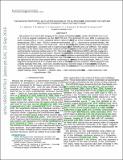Files in this item
The massive protostellar cluster NGC 6334I at 220 au resolution : discovery of further multiplicity, diversity and a hot multi-core
Item metadata
| dc.contributor.author | Brogan, C. L. | |
| dc.contributor.author | Hunter, T. R. | |
| dc.contributor.author | Cyganowski, C. J. | |
| dc.contributor.author | Chandler, C. J. | |
| dc.contributor.author | Friesen, R. | |
| dc.contributor.author | Indebetouw, R. | |
| dc.date.accessioned | 2016-10-11T11:30:23Z | |
| dc.date.available | 2016-10-11T11:30:23Z | |
| dc.date.issued | 2016-11-30 | |
| dc.identifier | 246547305 | |
| dc.identifier | f4acbc3e-bf89-475e-8c4f-d5bed1d177af | |
| dc.identifier | 85004107317 | |
| dc.identifier | 000390490100047 | |
| dc.identifier.citation | Brogan , C L , Hunter , T R , Cyganowski , C J , Chandler , C J , Friesen , R & Indebetouw , R 2016 , ' The massive protostellar cluster NGC 6334I at 220 au resolution : discovery of further multiplicity, diversity and a hot multi-core ' , Astrophysical Journal , vol. 832 , no. 2 , 187 . https://doi.org/10.3847/0004-637X/832/2/187 | en |
| dc.identifier.issn | 0004-637X | |
| dc.identifier.other | ArXiv: http://arxiv.org/abs/1609.07470v1 | |
| dc.identifier.uri | https://hdl.handle.net/10023/9644 | |
| dc.description.abstract | We present VLA and ALMA imaging of the deeply-embedded protostellar cluster NGC 6334I from 5 cm to 1.3 mm at angular resolutions as fine as 0.′′17 (220 au). The dominant hot core MM1 is resolved into seven components at 1.3 mm, clustered within a radius of 1000 au. Four of the components have brightness temperatures > 200 K, radii ∼ 300 au, minimum luminosities ∼ 104 L⊙, and must be centrally heated. We term this new phenomenon a "hot multi-core". Two of these objects also exhibit compact free-free emission at longer wavelengths, consistent with a hypercompact HII region (MM1B) and a jet (MM1D). The spatial kinematics of the water maser emission centered on MM1D are consistent with it being the origin of the highvelocity bipolar molecular outflow seen in CO. The close proximity of MM1B and MM1D (440 au) suggests a proto-binary or a transient bound system. Several components of MM1 exhibit steep millimeter SEDs indicative of either unusual dust spectral properties or time variability. In addition to resolving MM1 and the other hot core (MM2) into multiple components, we detect five new millimeter and two new centimeter sources. Water masers are detected for the first time toward MM4A, confirming its membership in the protocluster. With a 1.3 mm brightness temperature of 97 K coupled with a lack of thermal molecular line emission, MM4A appears to be a highly optically-thick 240 L⊙ dust core, possibly tracing a transient stage of massive protostellar evolution. The nature of the strongest water maser source CM2 remains unclear due to its combination of non-thermal radio continuum and lack of dust emission. | |
| dc.format.extent | 18 | |
| dc.format.extent | 837573 | |
| dc.language.iso | eng | |
| dc.relation.ispartof | Astrophysical Journal | en |
| dc.subject | Stars: formation | en |
| dc.subject | Infrared: stars | en |
| dc.subject | ISM: individual (NGC6334I) | en |
| dc.subject | Radio continuum: ISM | en |
| dc.subject | Submillimeter: ISM | en |
| dc.subject | QB Astronomy | en |
| dc.subject | QC Physics | en |
| dc.subject | NDAS | en |
| dc.subject.lcc | QB | en |
| dc.subject.lcc | QC | en |
| dc.title | The massive protostellar cluster NGC 6334I at 220 au resolution : discovery of further multiplicity, diversity and a hot multi-core | en |
| dc.type | Journal article | en |
| dc.contributor.sponsor | Science & Technology Facilities Council | en |
| dc.contributor.institution | University of St Andrews. School of Physics and Astronomy | en |
| dc.identifier.doi | 10.3847/0004-637X/832/2/187 | |
| dc.description.status | Peer reviewed | en |
| dc.identifier.grantnumber | ST/M001296/1 | en |
This item appears in the following Collection(s)
Items in the St Andrews Research Repository are protected by copyright, with all rights reserved, unless otherwise indicated.

